TOM HOOK’S UNUSUAL DREAM PROJECT
Tom Hook is best known as a fluent and good-humored stride pianist and singer. In his career he was a founding member of the New Red Onion Jazz Babies, worked with Bill Allred’s Good Time Jazz band, was an important part of the Black Dog Jazz Band, spent time as a stage performer, and also played with rock groups in addition to being a fixture in New Orleans.
When Rachel Domber of Arbors Records offered him the chance to make his dream album, Hook put together a continually surprising CD called 62. He gathered together a four-piece rhythm section that includes guitarist Danny Caron, bassist Bobby Durham, and drummer Ed Metz, plus a five-piece horn section, five strings, and five female vocalists. While he plays piano, the emphasis is on Hook’s vocals and his wide range of musical tastes, most of which focuses on early 1960s pop music; thus the CD’s title. Hook’s singing includes two collaborations (“Buona Sera” and “That Old Black Magic”) with Cristina Perez that find them coming close to sounding like Louis Prima and Keely Smith, and songs associated with Tom Waits, Big Joe Turner, and Frank Sinatra (“Come Fly With Me”). Other numbers include “Bounce Me Brother With A Solid Four” with a female vocal trio emulating the Andrews Sisters, “At The Swing Cat’s Ball” (which gives four of the horn players short solos), Perc
You've read three articles this month! That makes you one of a rare breed, the true jazz fan!
The Syncopated Times is a monthly publication covering traditional jazz, ragtime and swing. We have the best historic content anywhere, and are the only American publication covering artists and bands currently playing Hot Jazz, Vintage Swing, or Ragtime. Our writers are legends themselves, paid to bring you the best coverage possible. Advertising will never be enough to keep these stories coming, we need your SUBSCRIPTION. Get unlimited access for $30 a year or $50 for two.
Not ready to pay for jazz yet? Register a Free Account for two weeks of unlimited access without nags or pop ups.
Already Registered? Log In
If you shouldn't be seeing this because you already logged in try refreshing the page.




